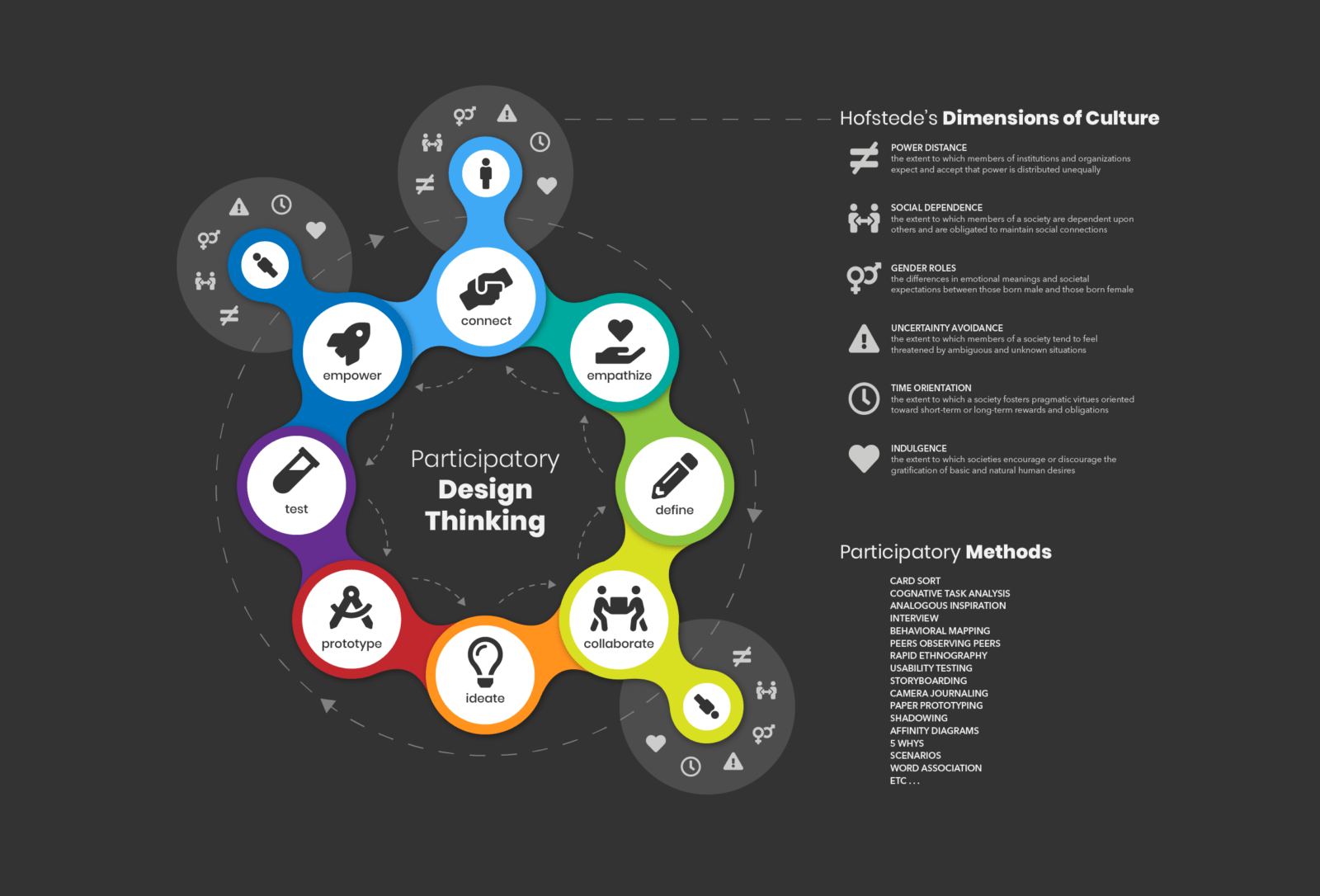Step 6 | Participatory Design Thinking


The Participatory Design Thinking model is a hybridization of Participatory Design methods with the Design Thinking workflow.
The traditional Design Thinking model (Empathize, Define, Ideate, Prototype, Test) is an iterative process of problem-framing, ideation, and prototyping. It is a highly effective model for producing collaborative ideas—though, at times, it can lack opportunities for designers and stakeholders to collaborate. The Participatory Design Thinking workflow attempts to address this separation by including participatory design methods in the Design Thinking workflow at several junction points.
These new junction points (Connect, Collaborate, Empower) will provide you with opportunities to undertake any number of participatory methods with stakeholders. These activities will create a process of reciprocal learning that allows you to simultaneously question your biases and discover alternative ways of thinking and doing.
Connect:
Begin by consulting the Method Cards in search of methods which allow you to make personal connections to your stakeholders. The point is to break the ice and put real names and faces to the people you’ll be designing with.
- Once you have made these preliminary connections, recreate the personas you made in Step 5, being mindful of any changes.
Empathize:
This stage of the Design Thinking process is to gain an empathic understanding of the problem you are trying to solve. This involves consulting experts to find out more about the area of concern through observing, engaging and empathizing with people to understand their experiences and motivations, as well as immersing yourself in the physical environment so you can gain a deeper personal understanding of the issues involved.
Empathy is crucial to design, allowing designers to set aside their assumptions about the world in order to gain insight into stakeholders and their needs.
Define:
During the Define stage, you will analyze your observations and synthesize them in order to define the core problems that you and your team have identified up to this point. You should seek to define problems from the perspective of your stakeholders. For example, instead of saying, “We need to increase the availability of healthy food options in low-income neighborhoods by 10%,” a much better way to define the problem would be, “Teenagers in low-income neighborhoods need to eat more nutritious food in order to thrive.”
The Define stage will help the designers in your team gather great ideas to establish features, functions, and any other elements that will allow them to address problems.
Collaborate:
In this step, you will revisit the Method Cards, this time in search of participatory methods which bring stakeholders into the design process.
Try to choose methods that allow stakeholders to “pick up a pen” and ideate on what they think a solution might look like. The insights generated by this might be impossible to implement—but that’s okay! What you are doing is allowing stakeholders to voice their concerns and share their knowledge. You will be learning from stakeholders’ first-hand experience, and they will be learning from you about how to systematically approach complex problems.
- This should not be a prescribed process, but a dynamic one. If you find that a certain method is not working, try another. If you find that your problem definition is shifting, shift the methods you are using accordingly.
- Once you have completed some participatory methods, again recreate the list of assumptions you made in Step 4, being mindful of any new changes.
Ideate:
During this stage of the Design Thinking process, designers are ready to start generating ideas. You and your team members can start to brainstorm new solutions to the problem statement you’ve created, and you can start to look for alternative ways of viewing the problem. It is important to get as many ideas out as possible at the beginning of the Ideation phase. Don’t worry about something being silly or impossible! At this stage, anything goes!
Prototype:
The design team will now produce a number of inexpensive, scaled down versions of the solution or any specific features found within the solution. Prototypes may be shared and tested within the team itself, in other departments, or on a small group of stakeholders outside the design team. This is an experimental phase, and the aim is to identify the best possible solution for each of the identified problems.
The solutions implemented within the prototypes are investigated and either accepted, improved and re-examined, or rejected on the basis of the stakeholders’ experiences. By the end of this stage, the design team will have a better idea of problems and constraints, and have a clearer view of how real stakeholders would behave, think, and feel when interacting with the final solution.
Test:
Designers or evaluators rigorously test the best solutions identified during the prototyping phase. While this is the final stage of the traditional Design Thinking model, this is meant to be an iterative process. The results generated during the testing phase are often used to redefine one or more problems and inform designers’ understandings of the stakeholders, the conditions of use, how people think, behave, and feel.
- Remember that this is not a completely linear process. If at any time in these stages you feel the need to reconnect with stakeholders, you should go back to the Method Cards in search of new ways to generate insights.
Empower:
The Participatory Design Thinking model takes things one step further. As a result of the participatory methods you have undertaken with stakeholders, a reciprocal relationship has been formed whereby the design team was able to learn from stakeholder experience and stakeholders were able to learn from the design process. The power of this reciprocal relationship is that it can, in a sense, make participants into design ambassadors. The simple colloquialism that “if you give a man a fish, he will eat for a day–but if you teach a man to fish, he will eat for a lifetime” could not be more appropriate here. By including stakeholders as participants in design, you expose these stakeholders to your own process, enabling them to use Participatory Design Thinking long after project deadlines have past.

 Previous Post
Previous Post Next Post
Next Post